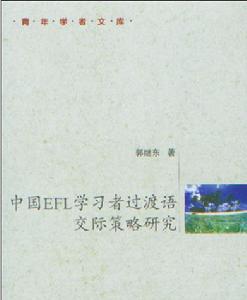基本信息
作者:郭繼東

叢書名:青年學者文庫
出版社:國防工業出版社
ISBN:9787118079920
出版日期:2012 年5月
開本:32開
頁碼:234
版次:1-1
內容簡介
《中國EFL學習者過渡語交際策略研究》採用定性分析和定量分析相結合的方法,對中國EFL學習者的過渡語交際策略進行了研究,研究問題基本涵蓋了中國學生英語,頭交際的主要情況。
目錄
《中國efl學習者過渡語交際策略研究》
chapter 1 introduction
1.1 introduction
1.2 rationale of this study
1.3 purpose and research questions of this study
1.4 organization of this book
1.5 summary
chapter 2 literature review
2.1 introduction
2.2 a brief historical overview of cs research
2.3 interlanguage
2.3.1 concept of interlanguage
2.3.2 starting point and Stages of intedanguage development
2.3.3 general features of intedanguage
2.4 communicative competence and strategic competence
2.4.1 hymes' model
2.4.2 canale and swuin's model
2.4.3 bachman's model
2.4.4 wen's model
2.4.5 celee-murcia's model
2.5 defining and classifying communication strategies
2.5.1 definitions
2.5.2 classifications of css
2.6 some typical empirical studies of css at home and abroad
2.6.1 cs classifications and research methods
2.6.2 factors affecting the choices of css
2.6.3 teachablity and teaching of css
2.6.4 effectiveness of css
2.7 summary
uhapter 3 research methodology
3.1 introduction
3.2 research questions
3.2.1 questions on cps and css
3.2.2 questions on cs use in oral tests
3.2.3 questions on css in interpreting
3.3 subjects
3.3.1 subjects for the study on css and cps
3.3.2 subjects for the study on cs use in the oral test
3.3.3 subjects for the study on css in interpreting
3.4 instruments and procedures
3.4.1 instruments and procedures for the study on cps and css
3.4.2 instruments and procedures for the study on css in the oral test
3.4.3 instruments and procedures for the study on css in interpreting
3.5 summary
chapter 4 conununirafion strategies and conununicafion problems
4.1 introduction
4.2 css and cps of all subjects
4.2.1 css of all subjects
4.2.2 cps of all subjects
4.3 css and cps of non-english majors
4.3.1 css of non-english majors
4.3.2 cps of non-english majors
4.4 css and cps of english majors
4.4.1 css of english majors
4.4.2 cps of english majors
4.5 discussion
4.6 summary
chapter 5 communication strategies in oral tests
5.1 introduction
5.2 overall distribution of css in the oral test
5.3 general language proficiency and css in the oral test
5.4 oral proficiency and css in the oral test
5.5 differences of cs use in oral test between gender groups
5.6 css in testing and non-testing situations
5.7 discussion
5.8 summary
chapter 6 communication strategies in interpreting
6.1 introduction
6.2 classification of css in interpreting
6.2.1 gist-obtaining strategies
6.2.2 gist-delivering strategies
6.2.3 asking for help (appealing)
6.2.4 using prefabricated patterns
6.2.5 restructuring
6.2.6 memorizing and retrieving
6.3 general beliefs about css in interpreting
6.3.1 interpreting is communication and interpreters are bound to employ css
6.3.2 cs competence is one of the components of interpreting competence
6.3.3 leachability of css in interpreting
6.3.4 interpreters' cs competence is developed mainly in interpreting
6.3.5 css should be one of the components of interpreting teaching
6.4 beliefs about the use of specific css in interpreting
6.4.1 overall distribution of the beliefs about cs use interpreting
6.4.2 beliefs about the cs use in interpreting and l2 proficiency
6.4.3 beliefs about the cs use in interpreting and gender
6.4.4 beliefs about the cs use in interpreting and interpreting experience
6.5 discussion
6.6 summary
chapter 7 couclusion
7.1 introduction
7.2 major findings
7.2.1 communication strategies and communication problems
7.2.2 communication strategies in oral tests
7.2.3 communication strategies in interpreting
7.3 implications
7.3.1 theoretical impheations
7.3.2 pedagogical implications
7.4 suggestions for further research
7.4.1 studying css used in written communication
7.4.2 studying css used on different stages of interlanguage development
7.4.3 studying css used in non-educational situations
7.4.4 studying css used in problem-absent situations
7.4.5 studying css from a reeeptive perspective
appendices
appendix i
appendix ii
appendix iii
appendix iv
bibliography
acknowledgements
